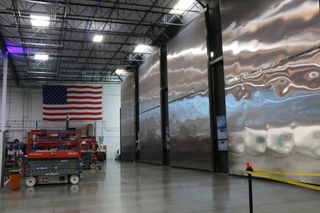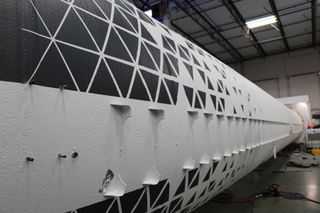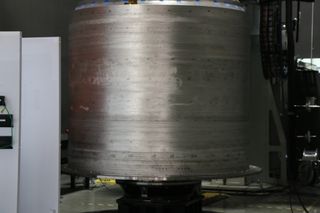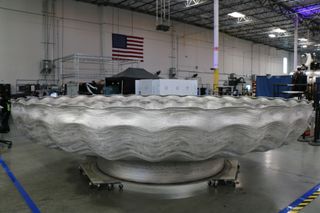Meet Relativity Space: the little 3D printing rocket company that could
LONG BEACH, Ca. — One fast-growing rocket start-up is 3D printing its way to space.
The space industry is in the middle of a historic boom. As industry giants take their first leaps and crewed voyages to outer space, new, smaller rocket companies continue to crop up, adding to the brewing frenzy to get to space faster, cheaper and better.
One of these new companies, a California-based start-up called Relativity Space, has big plans to 3D-print their way to space, and they’re gearing up for their first launch.
Related: Relativity Space will 3D-print rockets at new autonomous factory

From startup to launch
Relativity was founded in 2015 by Tim Ellis and Jordan Noone, two young aerospace engineers who had the big idea to create fully 3D-printed rockets. Before Relativity’s inception, Ellis was at Blue Origin and Noone was at SpaceX working on the Dragon capsule, Ellis told Space.com.
Relativity’s inaugural launch, set for early 2022, will see the company blast its Terran 1 rocket, a two-stage, fully 3D-printed rocket, into space in a test flight to show its viability. This will be the first launch of a completely 3D-printed rocket.
« We’re nearly there for the first flight. And, of course, since no one’s ever done that before, that’s so exciting, » co-founder and CEO Ellis told Space.com in August 2021. « We’re gonna launch our first rocket, and then we’re gonna keep scaling from there. »


The Terran evolution
Terran 1 is a fully 3D-printed, two-stage launch vehicle. But according to Ellis, it’s not just the first fully 3D-printed rocket, « it’s the largest metal 3D-printed object ever made. »
Standing at 110 feet (35 meters) tall with a diameter of 7.5 feet (2.3 m), Terran 1’s « whole primary structure is printed, » Ellis said. Terran 1 can deliver a maximum payload of up to 2,756 pounds (1,250 kilograms) to low-Earth orbit, according to Relativity.
« This is really unprecedented stuff, » he said. Nevertheless, « we feel very confident about it, » Ellis said.
Related: Relativity Space unveils fully reusable, 3D-printed Terran R rocket
Terran 1 is Relativity’s first rocket, but the company is already working on its next rocket: Terran R, which is both fully 3D-printed and completely reusable. This will be a major step forward from the expendable Terran 1. Terran R’s first stage, second stage and its payload fairing will all be reusable, the company has said.
The company announced the new, two-stage rocket in June 2021 and aims to begin launching with it in 2024.
Terran R, in addition to being reusable, is also a lot bigger and can carry a lot more along with it. Terran R stands at 216 feet (66 m) tall and measures 16 feet (4.9 m) wide and can launch over 44,100 pounds (20,000 kg) to low Earth orbit.
Both rockets are slated to launch from a pad at Cape Canaveral Space Force Station on the coast of Florida.
Why 3D print rockets?
Relativity’s main mission is to 3D print rockets. But why?
« Many other industries have adopted automation and software-driven technologies, » Ellis said. « That’s really all I see 3D-printing as being. It’s really just an automation technology that merges many, many parts together. So our goal is to have 100 times fewer parts for rockets. »
Ellis compared Relativity’s strategy with the space industry’s earliest days.
« The same fundamental premise of aerospace has really been unchanged since back when we started in Apollo, » he said. « It’s still just as true today as it was 60 years ago that we’re building products one at a time by hand in these giant factories full of fixed tooling with hundreds of thousands to millions of individual parts, all assembled with a bunch of manual labor across a very complicated supply chain. »
3D-printing, on the other hand, « simplifies the supply chain where our whole launch vehicle is only built with four raw metals, » Ellis said, adding that the process also allows the company to adapt quickly as its rockets develop.
« Ultimately, I believe that will be the holy grail of automation for aerospace, » Ellis said about 3D-printing.
Relativity is certainly not the first rocket company to use 3D-printing technologies. Companies like SpaceX, Boeing and Blue Origin have integrated 3D-printed different parts; Ellis helped to build Blue Origin’s printing capabilities during his time there.
But the scale of the company’s 3D-printing capabilities are unique. During a 2021 tour of Relativity’s California headquarters and printing facility, Josh Brost, Relativity’s vice president of business development, showed Space.com how the company is looking to do things differently.



During the tour, Brost showed off a Terran R being 3D printed. While earlier uses of 3D printing in aerospace have seen small components printed for use within a system, Relativity is working to print significant sections of a rocket all as one piece, dramatically reducing the individual number of pieces used.
This automation will, the company hopes, simplify the rocket-building process and make it more efficient. With more and more companies looking to launch their own satellite constellations, emerging technology and more, the demand for launch vehicles is growing quickly, Brost said.
« There’s this feeling in the industry that there is not enough affordable, reliable, timely launch capacity in the market to serve what everybody wants to do, » Brost said.
And, with fewer pieces, fewer steps and fewer raw materials, Relativity hopes that its unique approach can give the company a serious advantage when it comes to everything from cost to how long it takes to build a rocket from scratch.
« A normal rocket takes on the order of two years to build when you factor in long-lead hardware that they need to buy, » Brost said. « We’re working to be able to go from raw materials in the door to a launch vehicle leaving the door in 60 days. »
And the industry is starting to take notice of what Relativity has to offer.
In 2021, the company brought in substantial support from investors. In November of 2020, the company’s market value was placed at $2.3 billion and when Space.com spoke with Ellis in August 2021, he said that « we’ve raised about $1.2 billion over the last eight months or so. »
3D printing a future on Mars
While Relativity’s first launch will see the company really put its tech to the test, Ellis dreams that the company’s work will one day see the red surface of Mars.
« I was inspired by this idea of making humanity multiplanetary and going to Mars, » Ellis said.
But, as he explained, this dream depends on our ability to make it happen, and it won’t be easy.
« We are literally talking about replicating an entire planet with millions of people, » he said, adding that sending humans to Mars requires that we consider everything from actually launching off Earth to generating power, building new infrastructure, growing food and more.
Ellis already has a clear idea of how Relativity’s abilities could come in handy on Mars.
« I think 3D-printing is inevitably required to build an industrial base, » he said. « I think that the future on Mars and living on other planets won’t happen unless some company is the one that figures out how to build an industrial base with a high rate of automation, and very little touch labor, because that’s exactly the situation we’re going to be in on another planet. »
Ellis added that his dream of supporting humans in becoming a multiplanetary species isn’t solely tied to his company and that he hopes for this future even if Relativity isn’t the one to make it possible.
« Whether we’re the one to do it or not, I do think what we’re doing is important for the future of humanity, » he said. « It needs to happen eventually, so that’s what tells me it’s the right goal. »
Email Chelsea Gohd at cgohd@space.com or follow her on Twitter @chelsea_gohd. Follow us on Twitter @Spacedotcom and on Facebook.
